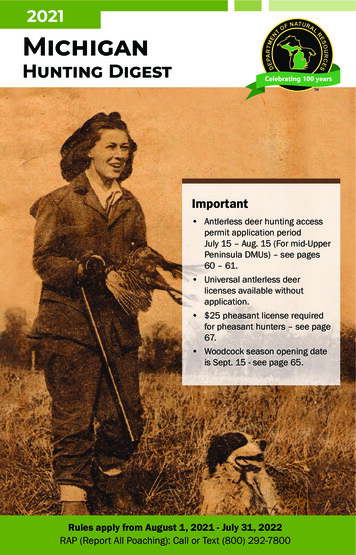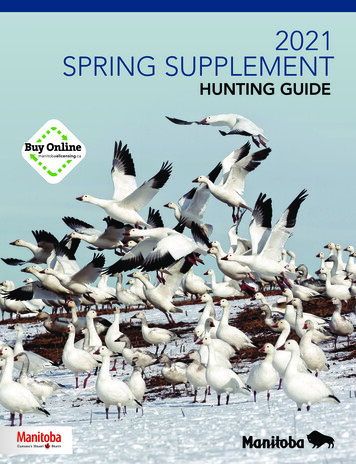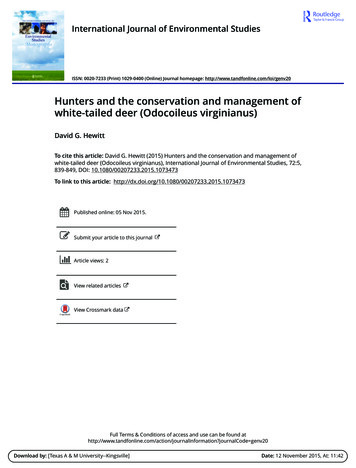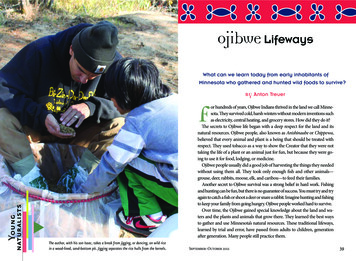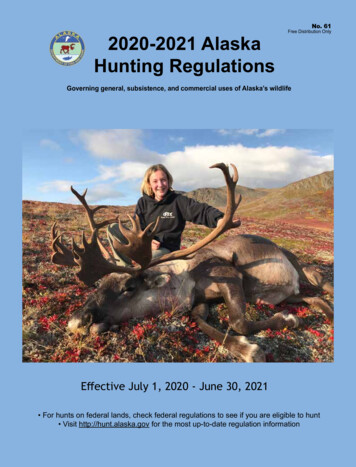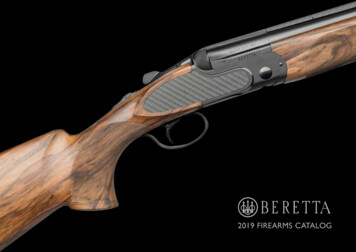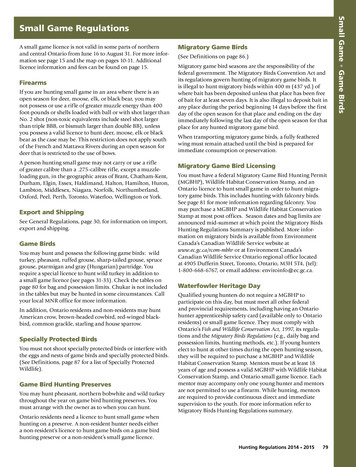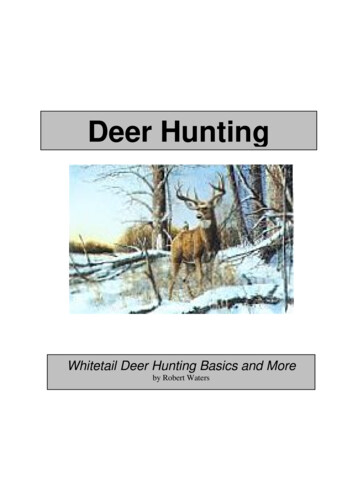
Transcription
Deer HuntingWhitetail Deer Hunting Basics and Moreby Robert Waters
Table Of ContentspageFOREWORD .4.5.7COMMON WEAPONS USED IN HUNTING DEER.10AUTHOR’S PREFACEINTRODUCTION.ChaptersI.II. MAJOR EQUIPMENT AND CLOTHINGThe “right” firearmClothing, Stands, ScentsMiscellaneous Equipment.12.23IV. BECOMING SKILLED IN WEAPON USEModern WeaponsArcheryBlack Powder.30V. WHERE TO HUNT .50VI. WHEN TO HUNT .53.57III. SAFETY .VII. COMMON METHODS OF HUNTINGHunting from standStill-hunting and StalkingDogsDrives Without dogsRattlingWhitetail Hunting Basics And More-2-
VIII. FAVORITE FOODS OF DEER.69BEING AT THE RIGHT PLACE AT THE RIGHT TIME73X.SCOUTING .75XI.BAGGING THE DEER .82XII. TRACKING WOUNDED DEER.88XIII. GETTING THE DEER OUT .90XIV. PREPARATION OF THE MEAT FOR THE TABLEField Dressing, Butchering, Aging, SpecialPreparation of the Meat - Favorite SARY OF TERMINOLOGY/INDEX.MISCELLANEOUS TIPS.Reminisces by Jerry Franklin .Meat by J.L.F.Venison Recipes - J.L.F.Resources: recommended reading, outfitters, tapes, etc.Hunter’s Check List .How To Build A Portable Tree Stand .Whitetail Hunting Basics And More.-3-
ForewordWhen Bob told me he was writing a book on whitetail deer hunting basics, and asked me to edit it, I thought, "Why is there needfor another book on deer hunting? There must be at least a bluemillion already in print." But as I began to read his words I realized again what I already knew, that Bob is an avid outdoorsman,an accomplished hunter, and a deadly shot with rifle, shotgun,handgun, and bow. Because of a lifetime of varied experiences,he has a lot to say. And the reason there is need for yet anotherbook on deer hunting, is because Bob is saying it, adding freshinsights to old ideas, giving new color and slants to proven concepts and methods. We are reminded that basic truths that enhance knowledge, which brings greater pleasure and happinessare always worthwhile. The reader will find excellent guidelinesand sound advice in this book. Whether they are just beginningto experience the joys of the out of doors and hunting, or are veterans of past years and numerous camps, many golden nuggets ofpractical advice will be gleaned from this book that will embellish the quality of the hunting experience, and add much to thesafety, pleasure, and success of the outing.Jerry L. FranklinWhitetail Hunting Basics And More-4-
AUTHOR'S PREFACEThe aim of this book is to help the beginning hunter learn thebasics of whitetail deer hunting and to develop the skill necessary for successful seasons year after year. While special attention has been given to basic fundamentals, the reader will findthis book thorough enough to give a beginner, a sometimes successful hunter, or an unsuccessful hunter, the knowledge andconfidence that he needs to bring home the venison and put it onthe table as a delicious meal.Those who have become proficient in the art of deer hunting areusually individuals who have constantly endeavored to learnmore about the whitetail and how to outwit this wily creature.This book has some ideas for such a person as well. It is also intended to encourage sportsmanship and to discourage the practices that cause some to look with disdain upon the sport of deerhunting.I am indebted to Jerry L. Franklin who has helped with theproofreading rewording etc. involved in the writing of this book.Jerry has also written the “forward” and contributed some interesting items included in the Appendix.One of Mr. Franklin's greatest contributions to this book is in thearea of firearms. Although he did not do the writing, he served asmy firearms consultant, and his qualifications give the reader assurance of sound advice where statements are made concerningfirearms. Mr. Franklin served in the U.S. Army for two years,starting in 1958. During this period of time he was on the FortLewis Sixth Army and All Army rifle teams. He won three “excellence in competition” (leg) medals during this time. He firedover 30,000 rounds with M1 Garands while in the military, andWhitetail Hunting Basics And More-5-
thousands of rounds in small bore competition. Because of hisexceptional marksmanship ability he was awarded the honor ofDistinguished Rifleman. He has instructed marksmanship bothwith small and big bore rifles and shotguns for many years, inand out of the military. Jerry continued to shoot after leaving themilitary, and uses his shooting skills in pursuit of the whitetailand other wild game.R.W.Whitetail Hunting Basics And More-6-
Introduction Whitetail deer hunting is the most popular big game huntingsport in America! This has continued to be a fact over the yearsfor many reasons. Whitetail deer are plentiful throughout America. Despite the fact that they are heavily hunted, whitetail deercontinue to produce more offspring than are harvested. In fact,they are becoming a nuisance in many areas because of overpopulation.The whitetail deer is a challenge to hunt. They can see, hearand smell better than human beings. Hunters find it challengingto go into the deer's territory and attempt to outwit them. A successful hunt means meat on the table, and if properly cared for,deer meat (venison) is healthy food with a delightful taste.Almost anyone who hunts can be fortunate enough to bag adeer occasionally. However, a consistently successful hunter is asportsman who can bring home legally taken venison year afteryear. The more successful hunters are those who spend fewerman-hours bagging a deer. But of course many hunters take greatpleasure in just being in the great outdoors. Their hunt is a success regardless of whether they bag a deer or not. Another measure of success is the size, length, and/or number of points the antlers have. Generally speaking, it takes a great deal more skill andpatience to take an old, smart buck than a younger deer. Therefore, some hunters prefer to pass up nontrophy deer in their pursuit of a trophy. The definition of a trophy may greatly differWhitetail Hunting Basics And More-7-
from one person to the next, and from one part of the country tothe next. On the other hand, some hunters aren’t interested in trophies, and hunt strictly for fun and for meat.Poachers are people who kill deer illegally. Poachers need torealize that most people, especially true sportsmen, do not admire or respect a poacher. Killing deer illegally is nothing tobrag about, and those who do it are likely to eventually getcaught. When one poaches deer, he is actually cheating his fellow sportsmen. Aside from the threat of being caught by the authorities and being looked upon as an outlaw, the poacher shouldrealize there will be occasions when he could have killed a largebuck if he had avoided disturbing the illegal deer. During the rut,bucks often trail does, but if a hunter shoots the doe he will neverknow the size of the buck that may have been trailing her. Thosewho give in to the temptation to take an illegal deer are not truesportsmen, and they contribute to the bad opinion many nonhunters have about true sportsmen.One of the greatest threats to the sport of whitetail deerhunting is the hunter himself. Unsportsmanlike habits displayedby some hunters are all too common. Spotlighting, carelessness,trespassing, leaving trash, damaging property, etc. leaves landowners with no alternative except to post or restrict the use oftheir land. A true sportsman will ask permission to hunt on private property and will show his appreciation in various ways ifthe landowner gives permission to hunt.There are those who do not approve of humans killing deerunder any circumstances, and not all of them are vegetarians. Ifthey had their way there would be no harvest of any deer by human beings. The result would be an overpopulation of deer. Starvation and disease, which kill in massive numbers, often followoverpopulation. Due to diminishing natural habitat and the popu-8Whitetail Hunting Basics And More
lation explosion of humans, predators that once kept the deerherds in balance are either gone or have been drastically reduced.This fact alone does not justify the slaughter of deer, but doesjustify thinning the herds. Killing for the sake of killing is behavior exhibited by immature individuals. Nevertheless, meat is andhas always been an accepted natural source of food. The truesportsman appreciates, respects and enjoys the forests and otherareas populated by deer, and attempts to harvest an animal fromthese areas only when he is confident of a quick, clean kill.Learning about whitetail deer hunting is like studying any ofthe sciences; it is a continual learning experience. Sources forlearning include: books, magazines, other hunters, videos, andactual experience. Deer are often unpredictable. However, as yougain knowledge regarding their habits and needs, and of the techniques of hunting, you will become more confident in your hunting ability, and more confident that you can have a successfulhunt.Whitetail Hunting Basics And More-9-
Chapter OneCommon Weapons Used In HuntingDeer The centerfire rifle is the most widely used weapon for deerhunting. It is the most reliable, offers the most versatility, and isthe most accurate. Shotguns with slugs are next in reliability,however, the length of time in which the law allows the use ofthese modern weapons is limited. Therefore, primitive weaponhunting has increased in popularity.Archery hunting has become increasingly popular in the last 30years. This is due mainly to the longer seasons offered for bowhunting and the uncrowded conditions during times when hunting with firearms is prohibited. Some hunters enjoy archery hunting so much they have completely given up hunting with otherweapons. The challenge of taking deer with any type of bow andarrow is much greater than with firearms. Each year, bow hunterssee dozens of deer they could have easily taken with a rifle orshotgun, which they will not attempt to shoot with a bow.Another category of weapons referred to as primitive weapons,are the muzzleloaders. Black powder and/or pyrodex propellants are used in these weapons. The traditional means of ignitingthe powder is either with a cap placed on the nipple, or by a flintWhitetail Hunting Basics And More-10-
attached to the hammer which upon striking metal causes a sparkin the flash pan. The latter type of muzzleloaders are seldomused for hunting, except by the purist.The major types of weapons used in hunting deer are pictured above:centerfire rifle; muzzleloading black powder rifle; shotgun; compoundbow; and crossbow.Whitetail Hunting Basics And More-11-
Chapter TwoMajor Equipment and Clothing The "Right" FirearmEvery sportsman wants to use the right firearm. However, thereis no firearm that is "best" for deer hunting in all situations. Infact some hunters have more than one weapon and make theirchoice based upon the situations they expect to encounter on agiven day. Large caliber weapons and shotguns with slugs aregood choices where a shot less than 100 yards is likely.In choosing the right weapon, one should consider his or her reaction to recoil. Recoil can cause flinching, or jerking of the trigger, resulting in poor shooting. Therefore, lighter calibers areordinarily fired more accurately by most hunters. A .22 caliberrimfire, though light in recoil is not an appropriate deer cartridge,and neither are some of the larger calibers that are light in power.Most of the felt recoil can be eliminated from a highpowered rifle by having a muzzle break and/or a special butt pad installed.The favorite weapons of a growing number of hunters are the 6millimeters and .25 calibers. These cartridges are considered toosmall by some hunters, however, if used with premium bulletsthey are highly effective, especially on smaller deer. Factoryloads with Nosler Partition bullets are marketed professionally,Whitetail Hunting Basics And More-12-
as are the Barnes X Bullets. The Barnes X Bullet is a solid pieceof copper with an expansion cavity, and is highly recommendedfor light calibers. (This is because some bullets in the smaller,light calibers will not hold together and pass completely througha deer.) This is usually because they are made with light jacketsdesigned for varmint hunting where longer shots are made. Whenthis occurs, a blood trail may be nonexistent and the deer may bedifficult to trail. If a weapon such as the .243 Winchester orsmaller is used, more care should be given to bullet placement.This is not to say that bullet placement is not important when using larger calibers.Because of higher velocity, the magnum rifles usually spoil moremeat than necessary, but they are particularly useful when hunting where a deer would be difficult to trail or to retrieve, such asin thick brush or tall weeds, or where hunters are numerous. Aquick kill might keep the deer from crossing a body of water orfrom traveling down a steep incline where it would be difficult toretrieve. A magnum might also keep the deer from running byanother hunter who might shoot at, and claim it for himself.There are several types of rifles commonly used in hunting deer:semiautomatic; bolt action; lever action; pump action; and thesingle shot. The venerable lever action Winchester 30-30 hascertainly left its mark in deer hunting history. However, semiautomatic and bolt action rifles are now more popular, primarilybecause of the ballistic limitations of the 30-30. Bolt action riflesare ordinarily more accurate than semiautomatics, more reliable,and the trigger is usually adjustable for weight of pull to suitone's preference. An important aspect of the semiautomatic isthat it allows the shooter to get off more shots at a moving deerbefore it gets out of sight or range. Also, gas or blow back operated rifles and shotguns have less felt recoil. Thus, they will bemore enjoyable to shoot and will likely be shot more accurately-13Whitetail Hunting Basics And More
in most situations. However, because of the fact that the hunteroften only get one shot, many hunters prefer the accuracy andreliability of bolt action rifles.Pictured above are some of the modern weapons used in hunting deer.From top to bottom: semiautomatic rifle; bolt action rifle; lever actionrifle; semiautomatic shotgun; and pump action shotgun. Single shot anddouble barrel not pictured.Some of the most popular and recommended calibers are included in the list that follows: .243 Winchester; Rem. .25-06;.270 Winchester; 7mm-08; .280 Remington; .308 Winchester;.30-06 Springfield; and the 7mm Remington Magnum. Ballistics charts are furnished free of charge by ammunition companies. To compare the ballistics of the above with the 30-30 Winchester, note the chart on the following page. (“FB” stands forflat base bullet.)Whitetail Hunting Basics And More-14-
----Long Range Trajectory Of Some Popular Calibers(Using BOATTAIL ------------Bullet 100 150 200 250 300 400 --------Cartridgewt.yds. yds. yds. yds. yds. yds. ---------.243 Win1001.9 1.6 0.0 -3.0 -7.6 -22.0 ----------.25-06 Rem.1001.9 1.6 0.0 -2.7 -6.9 -20.5 ----------.270 Win1401.8 1.5 0.0 -2.9 -7.2 -20.6 ----------7mm-08 Rem.1402.1 1.7 0.0 -3.2 -8.1 -23.5 ----------.280 Rem.1502.1 1.7 0.0 -3.3 -8.3 -24.2 ----------.30-30 Win FB1503.9 3.2 0.0 -6.2 -16.1 -49.4 -----------.308 Win.1502.2 1.8 0.0 -3.5 -8.7 -25.5 ----------.30-061652.1 1.8 0.0 -3.3 -8.2 -23.4 ----------7mm Rem. Mag1391.6 1.3 0.0 -2.5 -6.3 -18.3 -----------Whitetail Hunting Basics And More-15-
The Hunting KnifeA knife is an essential piece of equipment for the deer hunter.For wilderness hunts, most experts would recommend a small,lightweight knife with a 4 inch blade. It can be a sheath knife, ora pocket knife. Large heavy knives such as the Bowie Knife arenot practical for carrying on wilderness hunts, or hunts nearhome.Each hunter must make the choice of what is most practical on agiven hunt. Over the past thirty three years of hunting I have carried pocket knives, single blade folding knives, and sheath skinning knives. Most of my hunting has been near home, in whichcase deer were immediately loaded onto a vehicle and transported to a location for skinning and butchering. Also, for thelast ten years the bow and arrow has been my preferred choice ofweapon. Thus, a more versatile tool has been needed.The type of knife I have used on occasions over several yearswould be considered too long by most experts. Nevertheless, it iscapable of doing the job of several tools. It will do some thingsthat a hatchet or saw cannot do, and many things that cannot bedone with a small knife.One cannot expect a knife to do more than it was designed to do.There is no knife that is best for every situation, or that will doeverything well. Carrying more than one knife, and even a sawand hatchet is not practical. What if a knife could be designedwhich is reasonably light, stout, capable of being used in theplace of a hatchet or saw, suitable for field dressing, butcheringdeer, and capable of cutting small limbs with one stroke. Somewould have no interest in this type of knife because the only useWhitetail Hunting Basics And More-16-
they have for a hunting knife is to field dress their deer and thenmaybe use the same knife for skinning when they get home.Nevertheless, the knife I have built (pictured on the followingpage) does all the things mentioned above. I built it from a usedplaner blade that was given to me at a sawmill. The blade is 9”long, 3/4” wide, 1/8” thick and has an overall length of 14inches. (Pictured at the top in the illustration below.)With a knife similar to the longer one pictured above, one can cut a 3"limb or bush with only a few strokes by first bending it to one side. All ofthese knives were made by the author and each has their own purpose.A skinning knife is essential for tough jobs such as skinning furbearing animals (especially beaver), and is even helpful for skinning deer. But, considering the fact that after a few simple cutsthe skin can be pulled off, the need for a skinning knife (especially to carry when hunting) is not that great. If a skinning knifeis used there is no need for a long blade - a four inch blade islong enough. For skinning, I use one of two knives (pictured-17Whitetail Hunting Basics And More
above): 1) a short light skinning knife; or 2) a medium size, hollow ground knife used for delicate work.There are many fine knives on the market to choose from. In theevent you cannot find one to fit your needs, you can make oneyourself or have one made to your specifications.CLOTHINGWearing proper clothing is a key factor that may affect the success of your hunt. If you become chilled when on a stand, youwill not be able to remain patient and still. On the other hand, ifyou get too warm you will perspire. Deer are able to smell up to100 yards or more if air currents are unfavorable and you can beassured they will not come closer to identify the source of theodor.Woolen garments have long been used by the military because oftheir comfort under all conditions. Even when wet, wool still offers some protection from the cold. Down is probably the warmest, however it offers little or no protection from the cold whenwet and should therefore be used with a rain-proof garment. Thepopularity of new synthetic insulating materials is due to the factthat they dry more quickly than down, and continue to insulateeven if they become wet. New synthetics and wool are generallyfar less expensive than down. Nevertheless, down is still thewarmest and, if used with a rainproof garment, is an excellentchoice for extremely cold conditions.Sometimes it is necessary to walk long distances to the huntingsite. In such cases, it might be advisable to start out light andWhitetail Hunting Basics And More-18-
carry additional clothing. If you wear enough clothing whenwalking to ensure warmth while being still, you are certain to getexcessively warm and perspire. You can use a backpack to carryadditional clothing for use when needed. The idea is to staywarm and dry, but not too warm.It is not always practical to carry rain gear because of the extraweight and bulk. An inexpensive, lightweight substitute is a largetrash bag. Cut holes for your head and arms and you are readyfor a possible thundershower. It will also serve as an effectivewindbreaker in emergencies.Although it’s not essential, camouflage clothing will decreaseyour chances of being detected by deer. Even though they arethought to be color blind, whitetail deer can easily see white. Infact, their alarm signal is the flash of their white tail. Withoutcamouflage, the hands and face are most likely to be noticed, especially if you have a light complexion. Do not wear light colored clothing unless there is snow or sleet on the ground!STANDSA stand is a place where the hunter positions himself to wait fordeer. At this location, he may sit on a stump, log, build a blind onthe ground, build or take a stand in a tree (or climb into a tree),or use some kind of commercially built apparatus for gettingabove the ground. This section deals with the word stand particularly as it relates to equipment. Stands as a method of hunting, isdealt with in a later chapter.Many hunters build some kind of permanent stand in a tree, oruse portable climbing or ladder type stands. To build a permanent stand is to advertise your spot. Some portable stands are exWhitetail Hunting Basics And More-19-
pensive, noisy to move around, and are susceptible to theft andvandalism if left in the woods or field.It is a common practice for hunters to use "screw in steps" to getup into a tree. A light portable stand is pulled up into the treewith a rope and then secured. The steps are removed while not inuse, and are reinserted when needed.One method of constructing a seat in a tree (where the situationwill allow) is to use a strap approximately 2"x14', to make a seat.This is accomplished by tying and wrapping the strap around twolimbs that come out in a fork that also has a limb underneath onwhich to place the feet. You can sit on the strap and lean backagainst the trunk of the tree. It is not as difficult as you mightthink to locate a suitable tree, especially in fields and at the edgeof woods. The biggest problem is getting to the first limbs.Climbing steps can be used for this purpose.This size strap can be rolled compactly and will fit into your coatpocket. It is inexpensive, light, noiseless and surprisingly comfortable to sit on, and is very handy when necessary to drag adeer. Various sizes can usually be found at any Army Surplusstore.ScentsDeer have a keen sense of smell, and it would seem logical thatthe hunter could easily fool them by using sex and food scents.-20Whitetail Hunting Basics And More
Sents can be used effectively, but deer are intelligent and thescent used must be effective. Food scent must be food withwhich deer are acquainted, otherwise it may only alarm them.Urine or "doe in rut" scents have proved to be helpful for attracting deer, and for helping to mask the odor of humans. Althoughit is possible for such scents to keep the hunter from bagging thebig one. For this reason, some hunters believe that, “no scent isthe best scent.” Their efforts are directed toward holding downthe odor on their body and clothing. This is a good practice evenif scents are used.Many hunters claim successful results from using various typesof cover scents. The most common includes skunk, fox urine,and natural scents from plants. Where livestock are present,some hunters intentionally step in livestock manure. Obviousarguments could be made against coverscents, nevertheless theyare often effective.Miscellaneous EquipmentFor most of us, the amount and quality of equipment used is limited by interest, income and financial commitments. Even thougha firearm or bow and arrow, and a knife are the only essentialpieces of equipment, there are many items that contribute tocomfort and aid in outwitting the elusive whitetail. Due to newtechnology, hunting equipment is almost unlimited. The following is a partial list of items readily available and useful: rubberboots, hunter orange garments (when mandatory), gloves, flashlights, backpacks, binoculars (or monocular), range finders,saws, canteens, lighters, compasses, cords or straps, deer calls,antlers for rattling, decoys, timer clocks, cameras to be triggeredby deer, scent bombs, long range hearing devices and even handWhitetail Hunting Basics And More-21-
held blinds used for stalking. These, and other items can be ordered from outfitters. See appendix for outfitters.If the hunter is planning to camp or stay for an extended periodof time, the list goes on. (See the check lists in the Appendix.)Whitetail Hunting Basics And More-22-
Chapter ThreeSafety Anyone who hunts must realize that there is the possibility ofbeing injured in an unpredictable situation or by another hunter.However, if safety precautions are observed the chances of beinginjured in a car accident are greater than being injured whilehunting. The mandatory use of international orange during huntswhere firearms are being used has almost eliminated accidentalshootings where hunters are mistaken for deer. In fact, firearmsaccidents are on the decline and have been for many years. Agreat deal of credit for this can be attributed to the many safetyprograms implemented by the National Rifle Association.Proper handling of firearms, hunting safety, and sportsmanlikemeasures are being taught to young hunters in most states as aprerequisite to hunting without adult supervision, and to getting ahunting license. Some basic information on safety is to knowyour weapon. Know where the safety is and how to use it, andalways know whether the weapon is loaded or unloaded. Youand others who observe can see at a glance that it is unloaded orsafe if the action is open. When around other people, treat allfirearms as if they are loaded even when you know they are not.Never point a firearm of any kind in the direction of another person. Extreme care should be taken when loading and unloading afirearm because this is when an accidental discharge is mostWhitetail Hunting Basics And More-23-
likely. From the first time a person picks up a firearm to the dayhe retires to the rocking chair, he should make proper use of theweapon's safety. When you raise the firearm to discharge theround, the safety is taken off: when the firearm is lowered, thesafety should be put back on. This should become as automaticas breathing. Checking the safety periodically is a good practice.It will eventually become a conditioned reflex and will requirelittle conscious effort.Before loading a firearm, be certain the barrel is unobstructed.Also, be certain you have the correct ammunition. For example,a .308 Winchester cartridge will fit into the chamber of a .270Winchester. Since the .308 bullet is larger, firing it would almost certainly damage the weapon and would present extremedanger to the shooter.A danger that must not be overlooked is the possibility of thehunter suffering from frost bite or hypothermia (heat loss fromthe body). Hypothermia causes the greatest loss of life to the outdoorsman. When hunting in remote areas, extra precautionsagainst hypothermia are needed. Matches, rain clothing, windscreens, and a compass are items that should be carried along. Ifit is cold, do not take chances like walking on a log over astream. Be extremely careful along bluffs where there is water.Wet, mossy rocks can be as slick as ice. If you get lost or injured,do not panic. Seek or build a shelter, build a fire and wait forhelp.If you get cold, do something to warm up. You can walk, returnto camp or the vehicle, or perhaps build a fire. If available, drinkhot liquids. Never allow yourself to stay chilled for long. Probably the greatest danger of becoming chilled is when you are fatigued or when you get wet from unexpected precipitation. Anoverhanging bluff will offer protection from rain. A large tree,which leans to one direction will give some shelter from rain.-24Whitetail Hunting Basics And More
Avoid sitting on a rock because under cold conditions it can reduce your body temperature rapidly. (See the wind-chill factorchart below.)Airtemp.( F.)Wind spee
these modern weapons is limited. Therefore, primitive weapon hunting has increased in popularity. Archery hunting has become increasingly popular in the last 30 years. This is due mainly to the longer seasons offered for bow hunting and the uncrowded conditions during times when hunt-ing with
